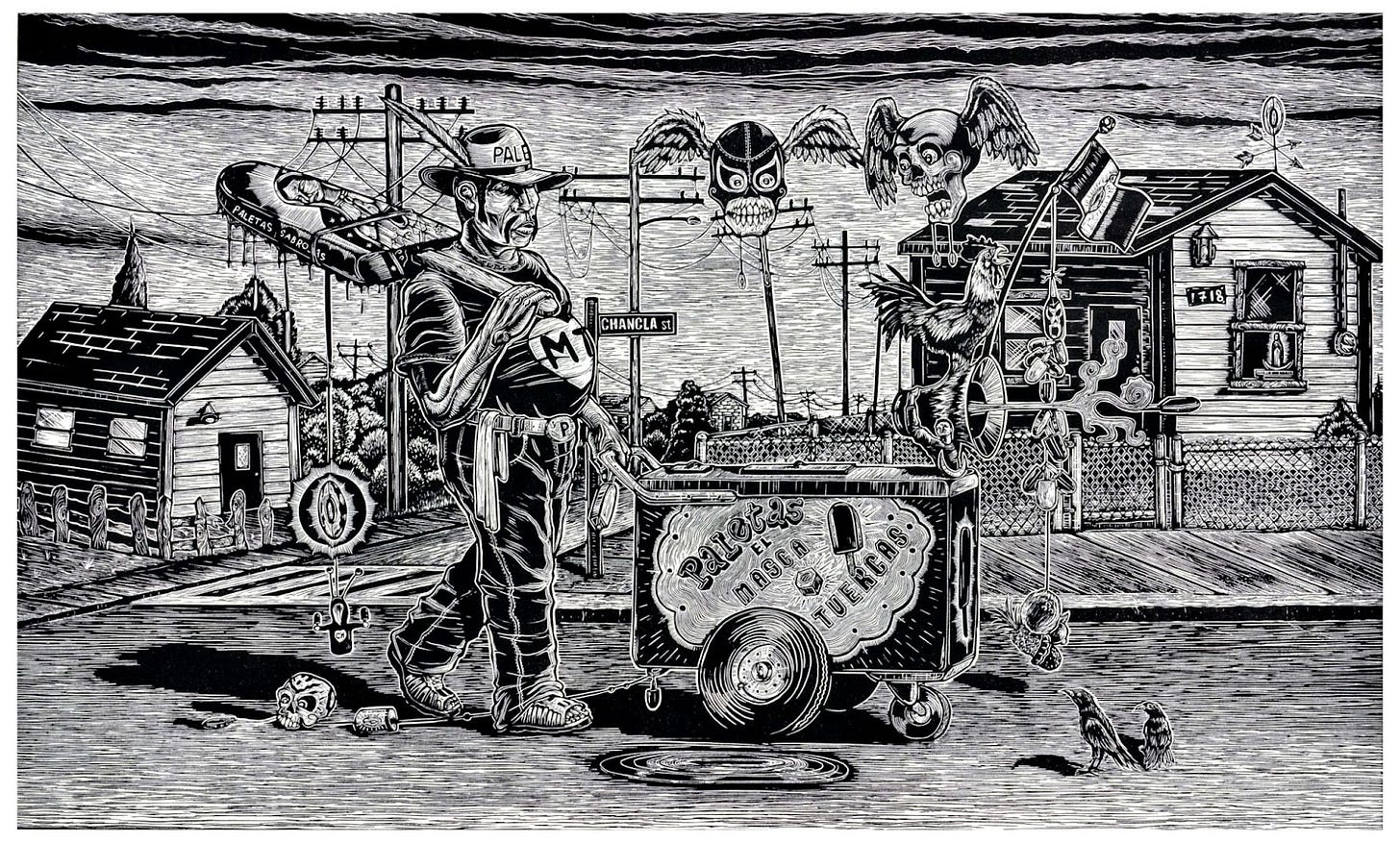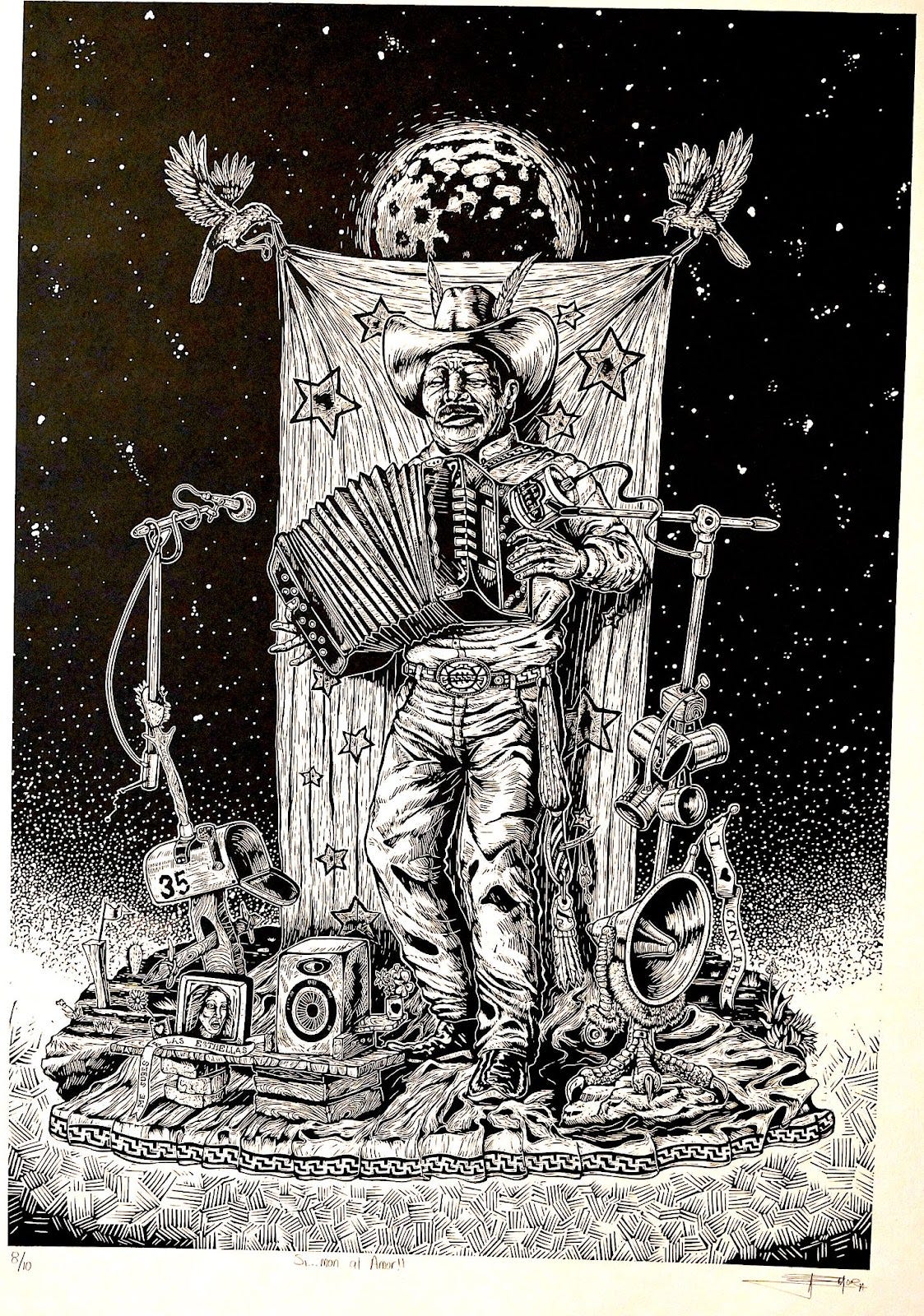Juan de Dios Mora: Borderland Artist and Master Printer
In June of 2019, the Smithsonian American Art Museum notified Juan de Dios Mora of their purchase of four of his art prints. To be a part of the Smithsonian collection is a special recognition, and only a few Texas artists have ever realized that goal. Mora’s creative, powerfully sharp, and detailed prints demonstrate his determination over many years to master both drawing and printing. His art shows a deep appreciation and understanding of the U.S.-Mexico borderlands.
Mora, “Paletero Des Filador” [Parade of the Popscicle]. Collection of Harriett and Ricardo Romo: A 2017 donation to the McNay Museum of Art.
One of the prints acquired by the Smithsonian, “King de la Wirira” [King of the Weed Eater] portrays a lawn worker proudly holding a weeder and grass blower in his hands. Bright rays of sunlight illuminate the background where the worker carries a rake and shovel on his back with lettered ribbons stating, “Sempre Hay Jale” [there is always work] and “Siempre chambeando” [always working]. A Smithsonian Newsletter noted that “Mora’s compositions elevate everyday people to heroic status, highlighting their rasquache or ‘making-do’ ethos.”
Mora, “King de la Wirra” [King of the Weed Eater]. Photo courtesy of the artist.
Juan de Dios Mora grew up in a small ranch community with a population of 500 in Acasico, Jalisco. His family made a living growing maize and alfalfa. As a young boy, Mora would follow his father in the fields to irrigate the rows of new crops. To escape boredom, Mora sat in the wet fields and created figures with the newly formed mud. He did not realize the significance of the playful activities, but if anyone had taken notice, those were the initial steps in the making of an artist.
During Mora’s youth, his father crossed the border into the United States to find seasonal work. Although he earned little as a low-skilled laborer, the money he sent home helped the family in the months between the planting and harvesting of the crops. For a time his father worked in Los Angeles and thought often of bringing his family with him to Southern California. In 1998 Mora’s dad took advantage of President Ronald Reagan’s Amnesty plan and emigrated with his family to the United States crossing the Texas border in Laredo. His father had thought of living and working in Los Angeles, but he chose to stay in Laredo, a community with the ideal small-town environment and ambiance for him and his family.
Mora was fourteen at the time of his family’s migration and his parents promptly enrolled him in English as Second Language classes at Christen Middle School. He took up drawing in middle school after his brother came home one day and announced that the art teachers provided free paper to draw and paint! While in high school he developed a keen interest in art. His development as an artist was largely a result of his artistic curiosity and a willingness to learn new skills in all the various phases of art-making. While in high school, he participated in after-school art classes which gave him a basic understanding of drawing and painting. But determined to know more, Mora joined the school art club which sold hand-made tee-shirts to raise money. His art club classmates taught him silk-screening.
Mora, “Si…mon al Amor.” Collection of Harriett and Ricardo Romo.
Following graduation from Martin High School, Mora attended Laredo Community College and the University of Texas-San Antonio [UTSA]. I met Mora in 2009 while he was enrolled in an art class with my good friend Malaquias Montoya. Montoya, a retired art professor from UC Davis and one of the founders of the Chicano art movement had agreed to spend a semester teaching art at UTSA. Montoya excelled as a muralist, but also shared his expertise in silk-screening with his students. Other visiting Chicano art professors Mora admired as role models included Alex Rubio, Richard Duardo, and Luis Jimenez. Mora referred to this time in his life as the “Renaissance” period, an era of great learning, and an era in which he felt most inspired.
Mora has converted a living room, a study, and his entire garage into his studio and workshop. In one room, he performs the first stage of his art– sketching on paper. He follows by transferring the image to a soft linoleum sheet. Using a sharp knife, he carves into the linoleum, a process that requires meticulous attention to small details. Linoleum is softer than wood, so power tools are not necessary.
Once the image is formed, Mora decides on colors. When working with small prints, he carefully mixes his preferred paint, a painstaking task made easier with years of practice. Next, Mora applies the desired color with a small roller to the relief linoleum impression. The final steps are a series of intricate prints based on the number of color separations he desires. For some of his smaller prints, Mora utilizes a printing press in his garage to complete each edition of prints, usually 50 of each image.
Mora, “Bien Arreglado” [All Decked Out] Collection of Harriett and Ricardo Romo: A 2017 donation to the McNay Museum of Art.
Glasstire Art critic Christina Rees wrote eloquently about Mora’s print exhibition at the McNay Museum in 2017. Rees stated: “Mora’s deftness with this medium can’t be fully grasped in reproduction here. The work is so nimble, textured, and detailed that it ripples across the page like water. Or cut glass. That Mora pairs this visual lusciousness with such trenchant subject matter is of course the thing that elevates the work from good to great.”
Mora was only one of a handful of Latino Texans [Tejanos] chosen by the Smithsonian American Art Museum for their exhibit “Printing The Revolution: The Rise and Impact of Chicano Graphics, 1965 to Now” [2019]. His print “El Animo es Primero” (Encouragement Is First) portrays a borderland resident who customized his wheelchair to mow lawns and earn money. The editors of the book exhibition noted that Mora’s work “celebrates the texture of transnational immigrant life and ways in which rasquachismo–a Chicano making-do sensibility–extends to new generations of Mexican-descent people in the United States.”
Mora, “Leading the Camino” [Leading the Road]. Collection of Harriett and Ricardo Romo: A 2017 donation to the McNay Museum of Art.
Mora is not content with simple expressions about the border and the immigrant experience. Critic Rees commented that Mora “loads up his images with recognizable symbols of religion, mythology, pop and street culture, and signage, and these generously ground the viewer as we meet up with his travelers and feel the limits and potentials of their various trajectories.”
Juan de Dios Mora takes pride in being part of the new generation of Chicano artists selected to show in museums like the Smithsonian in Washington, DC; the Amon Carter Museum in Fort Worth; and the McNay in San Antonio. His art and his extraordinary skill in print-making excite art lovers in communities beyond the Borderlands.
Juan Mora in his garage studio engaged in the color separation process for a new series. Photo by Ricardo Romo. 2022.








